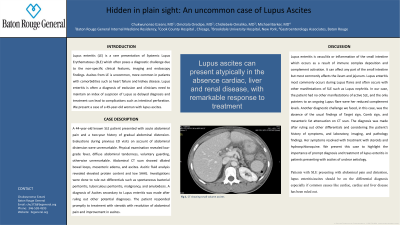Tuesday Poster Session
Category: Small Intestine
P4150 - Hidden in Plain Sight: An Uncommon Case of Lupus Ascites
Tuesday, October 24, 2023
10:30 AM - 4:00 PM PT
Location: Exhibit Hall

Has Audio

Chukwunonso B. Ezeani, MBBS
Baton Rouge General Hospital
Baton Rouge, LA
Presenting Author(s)
Chukwunonso B. Ezeani, MBBS1, Omotola Oredipe, MBBS2, Chidiebele Omaliko, MD3, Ogochukwu Ugochukwu, MBBS4, Oghenefejiro Ogwor, MD5, Ayobami Olafimihan, MD2, Michael Barker, MD6
1Baton Rouge General Hospital, Baton Rouge, LA; 2John H. Stroger, Jr. Hospital of Cook County, Chicago, IL; 3One Brooklyn Health-Brookdale University Hospital Medical Center, Brooklyn, NY; 4University of Nigeria, Baton Rouge, LA; 5St. Peters University Hospital, New Brunswick, NJ; 6Gastroenterology Associates, Baton Rouge, LA
Introduction: Ascites is a common gastrointestinal presentation that causes abdominal swelling and pain. Lupus enteritis (LE), an uncommon cause of ascites, poses a diagnostic challenge due to the non-specific clinical features. Patients may present with heart, kidney, or liver failure but LE can develop in the absence of these conditions. We present an interesting case of lupus ascites in a 49-year-old woman.
Case Description/Methods: A 43-year-old female with a history of SLE presented with acute onset abdominal pain and nausea. She also reported 7-8 episodes of non-bloody diarrhea, nausea, anorexia, 15 lbs. weight loss, and low-grade fever. Over the two years prior to presentation, she has had slowly progressive abdominal distension. Prior evaluations including abdominal ultrasound, and CT were unremarkable except for a retroperitoneal lymph node. She had abdominal paracentesis, but the cytology was unremarkable. Mycophenolate mofetil was stopped due to recurrent Covid-19 infection; she takes hydroxychloroquine.
Physical exam revealed hypertension (141/65 mmHg), tachycardia (100 beats per minute), low grade fever, mild abdominal distension with diffuse tenderness and voluntary guarding. Laboratory data revealed hyponatremia, neutrophilic leukocytosis, normocytic anemia and a high protein gap, elevated serum IgG (Table 1). CT scan revealed dilated small bowel loops, mesenteric edema, and ascites with diffuse mesenteric edema. She received broad spectrum antibiotics due to concern for spontaneous bacterial peritonitis, which was discontinued as ascitic fluid analysis only showed high protein, low SAAG but neutrophils of 104 cells/uL Extensive analysis including CA 19-9, CA-125, hepatic vein doppler ultrasound, pelvic ultrasound was unremarkable. A diagnosis of lupus enteritis was made after ruling out potential diagnoses. She responded promptly to treatment with steroids with the resolution of abdominal pain and swelling.
Discussion: Lupus enteritis most commonly occurs during Lupus flares and often occurs with other manifestations of SLE such as Lupus nephritis. However, as in our case, it can be the only presentation along with reduced complements. Typical CT findings of Target sign, Comb sign, and mesenteric fat attenuation can be absent. The diagnosis was made after ruling out other differentials. Treatment with steroids and hydroxychloroquine is effective. We present this case to highlight the importance of prompt diagnosis and treatment of lupus enteritis.
Disclosures:
Chukwunonso B. Ezeani, MBBS1, Omotola Oredipe, MBBS2, Chidiebele Omaliko, MD3, Ogochukwu Ugochukwu, MBBS4, Oghenefejiro Ogwor, MD5, Ayobami Olafimihan, MD2, Michael Barker, MD6. P4150 - Hidden in Plain Sight: An Uncommon Case of Lupus Ascites, ACG 2023 Annual Scientific Meeting Abstracts. Vancouver, BC, Canada: American College of Gastroenterology.
1Baton Rouge General Hospital, Baton Rouge, LA; 2John H. Stroger, Jr. Hospital of Cook County, Chicago, IL; 3One Brooklyn Health-Brookdale University Hospital Medical Center, Brooklyn, NY; 4University of Nigeria, Baton Rouge, LA; 5St. Peters University Hospital, New Brunswick, NJ; 6Gastroenterology Associates, Baton Rouge, LA
Introduction: Ascites is a common gastrointestinal presentation that causes abdominal swelling and pain. Lupus enteritis (LE), an uncommon cause of ascites, poses a diagnostic challenge due to the non-specific clinical features. Patients may present with heart, kidney, or liver failure but LE can develop in the absence of these conditions. We present an interesting case of lupus ascites in a 49-year-old woman.
Case Description/Methods: A 43-year-old female with a history of SLE presented with acute onset abdominal pain and nausea. She also reported 7-8 episodes of non-bloody diarrhea, nausea, anorexia, 15 lbs. weight loss, and low-grade fever. Over the two years prior to presentation, she has had slowly progressive abdominal distension. Prior evaluations including abdominal ultrasound, and CT were unremarkable except for a retroperitoneal lymph node. She had abdominal paracentesis, but the cytology was unremarkable. Mycophenolate mofetil was stopped due to recurrent Covid-19 infection; she takes hydroxychloroquine.
Physical exam revealed hypertension (141/65 mmHg), tachycardia (100 beats per minute), low grade fever, mild abdominal distension with diffuse tenderness and voluntary guarding. Laboratory data revealed hyponatremia, neutrophilic leukocytosis, normocytic anemia and a high protein gap, elevated serum IgG (Table 1). CT scan revealed dilated small bowel loops, mesenteric edema, and ascites with diffuse mesenteric edema. She received broad spectrum antibiotics due to concern for spontaneous bacterial peritonitis, which was discontinued as ascitic fluid analysis only showed high protein, low SAAG but neutrophils of 104 cells/uL Extensive analysis including CA 19-9, CA-125, hepatic vein doppler ultrasound, pelvic ultrasound was unremarkable. A diagnosis of lupus enteritis was made after ruling out potential diagnoses. She responded promptly to treatment with steroids with the resolution of abdominal pain and swelling.
Discussion: Lupus enteritis most commonly occurs during Lupus flares and often occurs with other manifestations of SLE such as Lupus nephritis. However, as in our case, it can be the only presentation along with reduced complements. Typical CT findings of Target sign, Comb sign, and mesenteric fat attenuation can be absent. The diagnosis was made after ruling out other differentials. Treatment with steroids and hydroxychloroquine is effective. We present this case to highlight the importance of prompt diagnosis and treatment of lupus enteritis.
Disclosures:
Chukwunonso Ezeani indicated no relevant financial relationships.
Omotola Oredipe indicated no relevant financial relationships.
Chidiebele Omaliko indicated no relevant financial relationships.
Ogochukwu Ugochukwu indicated no relevant financial relationships.
Oghenefejiro Ogwor indicated no relevant financial relationships.
Ayobami Olafimihan indicated no relevant financial relationships.
Michael Barker indicated no relevant financial relationships.
Chukwunonso B. Ezeani, MBBS1, Omotola Oredipe, MBBS2, Chidiebele Omaliko, MD3, Ogochukwu Ugochukwu, MBBS4, Oghenefejiro Ogwor, MD5, Ayobami Olafimihan, MD2, Michael Barker, MD6. P4150 - Hidden in Plain Sight: An Uncommon Case of Lupus Ascites, ACG 2023 Annual Scientific Meeting Abstracts. Vancouver, BC, Canada: American College of Gastroenterology.
